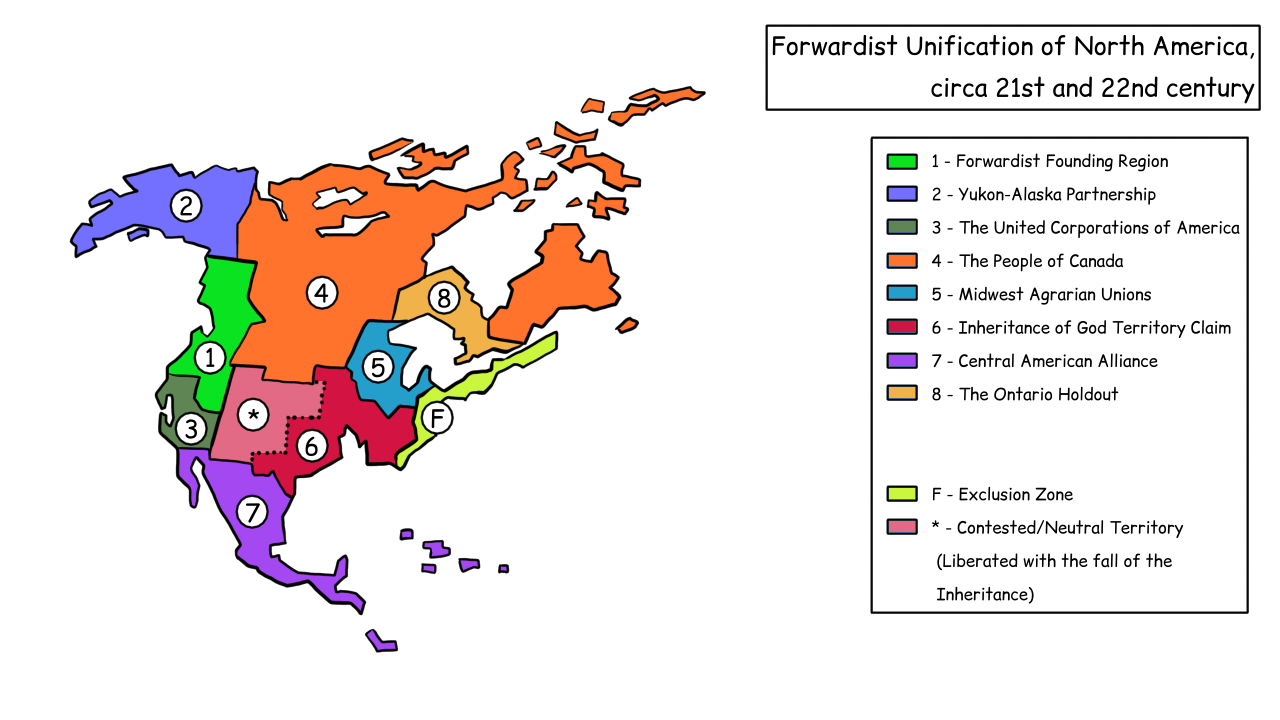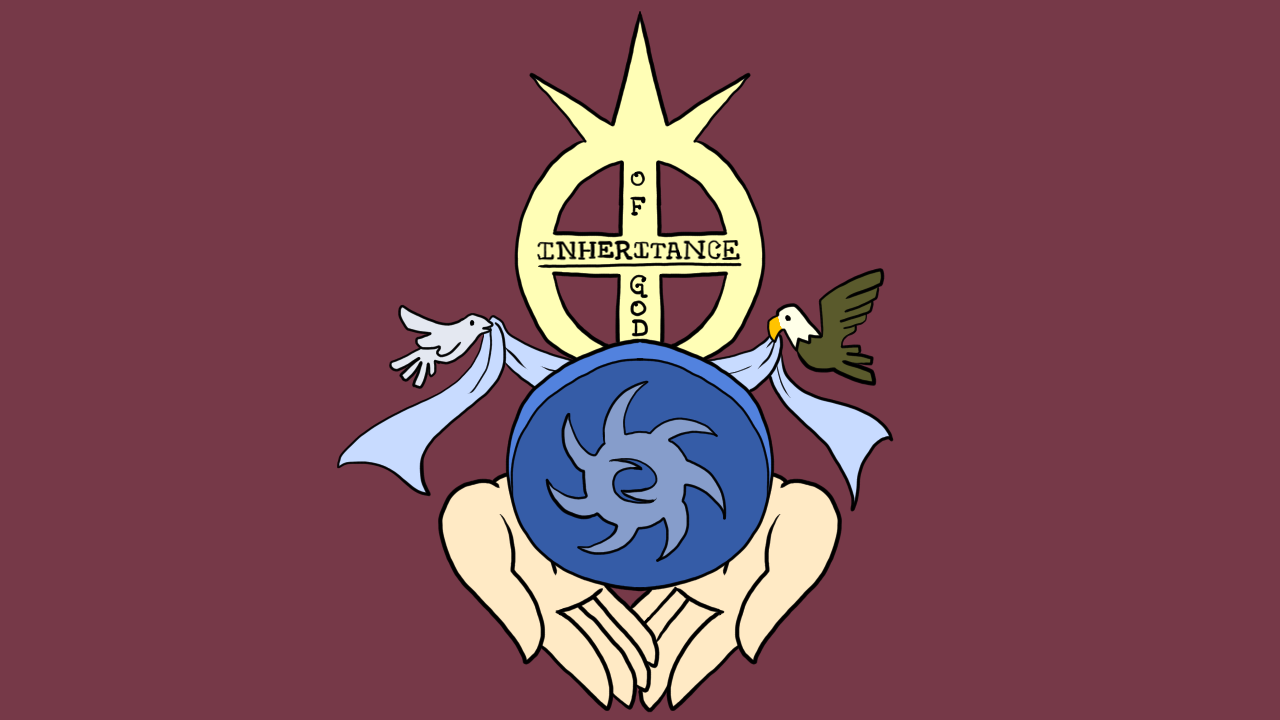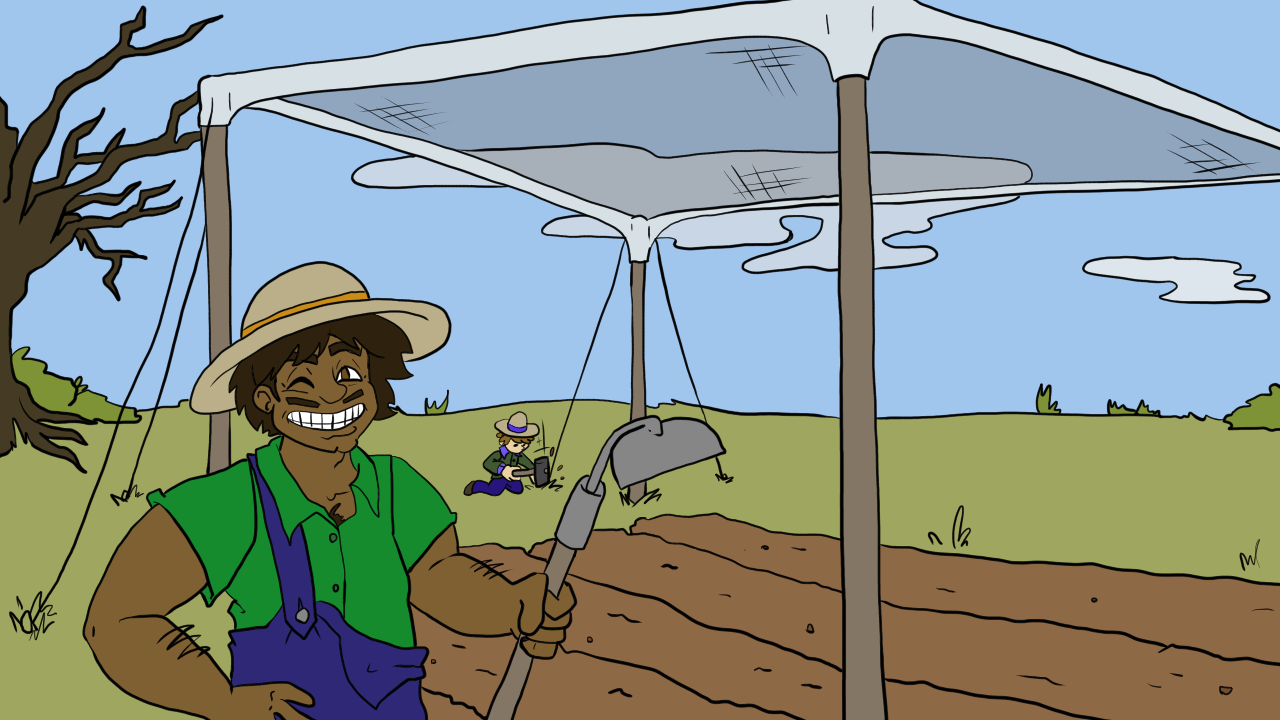Post-Collapse American History

When the United States of America's national government was obliterated in 2032, life as it was known in the early 21st century was quickly eradicated. In its place, chaos and terror reigned. There were no true leaders who were willing or able to step forward and help the nation get back to its feet. Other nations were either unable to help the USA because they were facing difficulties of their own, or they were unwilling to help because of strained social relations (or in some cases, a combination of factors).
There were some groups who did come forward, claiming they could help, but the solutions they provided came at either a cost, or they were only viable on a small-scale. For instance, Canada offered to provide resources to several states in exchange for joining the Canadian nation. This did help these states to restabilize, but it was unable to help anyone in the rest of the states, and the states annexed were discouraged from accepting refugees. Thus, only current residents of these states saw any benefit from this aid. Without help from external forces, American citizens were left on their own to try to pick up the pieces of a broken world.
Table of Contents
- 1. The Collapse
- 2. After The Collapse
- A. The United Corporations of America
- B. Post-UCA America
- i. Eastern Midwest Response
- ii. Western Midwest Response
- ii. Southern Response
- iii. Violence in the South
- iv. Resolutions in the South
- C. Forwardist Rebuilding Efforts
- i. Rebuilding in The US and Canada
- ii. Building Efforts Further South
The Collapse
^ Back to table of contents ^The American Government collapsed in 2032 when a series of severe hurricanes destroyed several nuclear power plants along the east coast of the United States. Almost a third of the nation's population was killed, and those that survived the deadly hurricanes were dealt a death blow by the leaking radiation from the damaged nuclear power plants. Visit the Confederation page to learn more about this devastating event.
After The Collapse
The United Corporations of America
 ^ Back to table of contents ^
^ Back to table of contents ^
The first major group who rose to power with the claim to end the suffering of the people, and to help restore life to the way it had been before the collapse was called the United Corporations of America. Its center of power was in California, and it was made when several of the largest, most powerful corporations in America merged into a conglomerate. They promised to repair the country's infrastructure and make sure all of the citizens of America still had access to everything they needed to get by.
Across the world, humanity had been forced to acknowledge the severity of the climate's changes, and most acknowledged the causality of human action in these changes. It became a top priority to change our behavior to halt and reverse the damage done. In order to do this, it was necessary to improve carbon capture technology along with eradicating human actions that produced carbon gasses that contributed to climatological changes. This included most types of industry, and it also meant humans had to find ways to survive without relying on fossil fuels for energy. While this was not an easy transition, people were committed to salvaging the planet. Most people in the states returned to a simpler way of life, though out of necessity rather than a conscious choice.
Despite the promises of the UCA, only the states furthest to the west were able to rely on having access to regular shipments of supplies. Transportation costs skyrocketed due to shortages of fossil fuels, which in turn made it less profitable to ship food to the whole country than it was to simply sell it close to home. As a result of this, states as far west as Colorado and New Mexico, as well as everything east of them, had to find food and other resources without help from the UCA. Most citizens turned to growing their own food wherever possible, and it was a lean time for most.
The UCA was unable to keep its promises of safety, security, and stability to most of the citizens. They were unable to provide access to reliable resources to most of the Americans across the country, with the exception of those in California and the surrounding states. In these areas, the UCA had managed to return some amount of normalcy, though life there was still strained for many. Although the national economy had failed, the UCA decided to continue functioning as a capitalist business, offering access to much-needed resources only to those with wealth to pay for it. Those at the head of the corporation were those with access to the most power and wealth when the USA collapsed. As before the collapse, those in power had unlimited access to what they needed, and they felt no strong urge to make sure everyone else had the same access. The only ones who were given the same privileges were celebrities, the wealthy, and public figures. While other residents in the area could typically find what they needed to survive, resources were distributed based on who could pay for them, so many people still struggled.
In addition to providing inadequate resources to most of the Americans in need, the UCA was also failing to prioritize its environmental impact. They continued producing and distributing goods in ways that did not prioritize reduction of their carbon footprint, in spite of the eco-friendly recommendations of the remaining states' governments. They claimed these adaptations would have been too difficult to implement into their supply lines when they were questioned on their failing to comply with environmental impact regulations.
The governing bodies in the states further to the east declared Martial law when it became clear that the UCA was completely failing to deliver adequate resources, and other states didn't take long to follow when the UCA's environmental impact reports were made public. California and Nevada were the only states that the UCA had its roots in deeply enough to maintain control. Meanwhile, the rest of the states were thrown into chaos and, in many cases, violence.
Post-UCA America
Eastern Midwest Response
^ Back to table of contents ^When the American citizens realized that the UCA was not the answer to their problems, no one knew who to turn to, and each region of the country found different solutions. The eastern states had droves of refugees fleeing the radiation, mostly making their way to the midwest. In this region, most people were able to grow food as needed for their families and communities. Even with the increased population from refugees, cities were restructured to ensure everyone had a place to call home. Because the land is fairly fertile in this region, they were able to focus on subsistence farming as a primary means of supporting their communities.
Western Midwest Response
^ Back to table of contents ^Further west of this region, Idaho, Montana, Wyoming, and the Dakotas were offered refuge by the Canadian government. In exchange, they were annexed into the country, to be added to pre-existing infrastructure. The people of the region were grateful for the return to normalcy, and the nation they were a part of didn't really seem all that important compared to the reality of starvation.
Initial Southern Response
 ^ Back to table of contents ^
^ Back to table of contents ^
When the UCA failed to provide adequate resources, the primary groups who stepped up and took care of the citizens in the south were Christian groups. Initially, they were willing to offer help to anyone in need, but as conditions declined, they retracted this stance. Communities developed with the help of the organization provided by these churches, and when resources grew scarce, they began to refuse to aid anyone other than members of their congregations. Because communities had formed based on the aid from these religious groups, even those outside of the religion were dependent on them for their necessities. When outsiders were suddenly denied resources that had been promised, there were some instances of violence, but most cases were resolved peacefully.
When turned away by the Christian churches, those that had been excluded grouped together with the intention of securing the necessary resources for everyone who the Christian groups denied. Communities were formed with the promise to provide resources for anyone who needed them, regardless of their beliefs. It took several years for the communities to stabilize, but they were perservering, and found ways to feed and shelter everyone in the community and any who sought refuge there. Historical accounts indicate that the group primarily aimed to waste as little food as possible during its processing. They also collected and cultivated locally-growing edible plants that had previously been considered undesirable. With creative preparation, they were able to make new dishes from local plants previously considered weeds, such as "milkweed-pod poppers," "sauteed dandelions," (additionally, dandelion petals were often prepared and frozen, to be added as a flavorant in baking and cooking), "chickweed chowder," "crabapple cider," and many more.
These all-inclusive groups began to thrive, while the specifically Christian-led organizations were still struggling. Relying on traditional food sources became insufficient, but most of these groups were resistant to change and were unwilling to look for other ways to feed their population. They primarily relied on livestock and animal by-products for sustenance with only some agriculture. Eventually, the already scarce supplies became even more difficult to produce as a result of climate change. Especially in the southern region of the United States, it became more difficult to grow crops and provide enough feed for livestock when the intense heat caused many crops to be scorched in the sunlight.
The lack of adaption to the ever-changing landscape led to famine. The insufficient resources led to rising tensions, and the primary group to emerge was called "The Inheritance of God," or simply "The Inheritance." This was a Christian supremacist group that believed what was told in the book of Revelations had come finally come to pass, and that the end of days was upon the world. Many of them believed rapture was yet to come, while others believed that the Earth was to be cleansed and reborn. Their name originates from their belief that they were the rightful inheritors of the Earth, and that God had created World-Ender as a way to cleanse the world of all its impurities. The group had come to the conclusion that it was necessary to abandon many of the comforts they used to know; they saw World-Ender as God's message that their lives had become corrupted with complications that distracted from what God wanted for them. This translated into abandoning the use of all advanced technology, keeping only basic tools. In communities led by the Inheritance, it was seen as a moral failing to rely on any form of technology (firearms being a notable exception).
While many of the other groups were utilizing what had previously been considered "weeds" for food, this alone was not enough for sustenance. They also had some livestock, but they were mostly reliant on plants they they grew for food, and they faced the same agricultural struggles as the Christian groups. The sun's rays would often burn the leaves of plants as they grew, at least until someone developed a sun-filter. With a little bit of ingenuity (and an engineering background, if the stories are to be believed), someone was able to develop a type of mesh filter that was made to cover 8 foot x 8 foot plots of land. It looked similar to a 21st century canopy tent, but the top was flat instead of pointed, and instead of being a sheltering material, it was just a simple mesh that reduced the amount of heat and UV rays that got to the plants below it.

While the original inventor of this device has been highly contested, many believe it was created by a woman who had been an engineering student before the collapse. Regardless, the invention was highly practical, and was wildly successful in the communites that adopted its use. While the invention was published as a free blueprint that anyone could make, many of the Christian groups were resistant to even this type of technological change, despite their struggles with food. Few of the Christian groups were willing to adopt its use in agriculture, while the majority were opposed to adding any additional forms of technology to their lives. Most groups were content to simply try to make do with what little they had, but the Inheritance saw it as an affront. They believed that God no longer wanted humans to use technology, that it was a sin, and that using technology like this was in direct opposition to the message they had received from God.
Violence in the South
^ Back to table of contents ^The first incident of violence the Inheritance displayed was in July of 2058. A small town called "La Paz" had grown in the remnants of Oklahoma, and they were one of the many groups founded after the Christian groups were unable to provide resources for them. The city prided itself on including people of all religions and backgrounds, and its most notable feature was that it had a large variety of people living within it. In the incident that came to be known as "la muerte de la paz," a group from the Inheritance launched an attack on the town. The attackers came to the town and demanded that they stop using the sun-filters immediately. When the town refused to meet the demands, which would have led to their starvation, the attacking group responded with violence.
The leader of the group was reported to have responded "Your use of technology is an affront to God, and we will not abide it. Return to the old ways or perish." Immediately after speaking, he pulled out his firearm and shot one of the citizens of the town. He and other members of the group continued to shoot at the civilians. Meanwhile, another group had been waiting, and at the signal of gunfire, they laid down salt in the soil the town was using to grow their food, and then they burnt the fields down. There were over 70 casualties that day, and this was only the first in a series of similar events.
These types of atrocities were waged against anyone who was unwilling to follow the demands of the Inheritance, and very few places had the ability to adequately defend themselves against these types of attacks. As a result, most of the people living in towns like these fled the area, moving to northern states, or in some cases, especially in Texas, people fled down to Mexico. This efflux of people left the south significantly destabilized. By the turn of the century, the population of the southern states had been halved as a result of violence and starvation. Even Christian groups that weren't a part of the Inheritance weren't immune to the hostility from the group, but they weren't targeted as harshly or as quickly, so they were able to survive longer than other groups, but even they were eventually driven from the area.
Resolutions in the South
^ Back to table of contents ^By 2120, most of the southern United States was a barren wasteland, with few people except the Inheritance. These communities were floundering, and had no sustainable food sources. Most of the food they had been getting was from the groups they attacked, but with no one left around, they were backed into a corner. Too many opinions about how to save their communites were thrown around, and not enough choices were actually made. The Inheritance splintered off into several smaller groups that were ultimately still unsuccessful at providing for themselves. Later that year, the Forwardist confederation sent emissaries when no one had heard anything from the Inheritance (or the southern states at all, for that matter) in a few months.
The emissaries found the shattered remains of the Inheritance, which was mostly just individual families that had decided to leave the group in favor of looking after themselves. The most zealous members of the Inheritance were nowhere to be found, and it was theorized they either moved into bunkers or moved further east, into the exclusion zone. None of the remaining families were working together, and none of them had enough to survive. The emissaries sent word of the grave situation, and an outcry of compassion came from the Forwardist Christians, and they offered the people in the south access to the resources they would need to survive and rebuild their communities. The only condition they had for it was that the former Inheritance members needed to join the confederation for the sake of ensuring none of the atrocities of the past could happen again. The Forwardist confederation sought to preserve the rights of all, and they saw this as their primary duty; the citizens of the south decided that the terms were agreeable and joined the Forwardist confederation, forming some of the first Forwardist communities in the southern part of the country. It wasn't until around 2160 that most of the people in the southern states had gotten their communities re-established, now under the Forwardist confederation.
Forwardist Rebuilding Efforts
Rebuilding in The US and Canada
^ Back to table of contents ^The Forwardist Confederation had grown to cover most of the United States (except for the southern states held by the Inheritance) and a large proportion of Canadian territory by the year 2100. The area that had previously been claimed by the UCA had been converted into Forwardist communities, and most of Canada had joined the confederation as well (including the newly-annexed areas). The transition from Canadian citizens considering themselves a part of the Canadian State to the Forwardist confederation was a gradual one. Because the Forwardist confederation was an ideological group above all else, many Canadian citizens started as merely sympathetic to the group's ideas. Over time, the Forwardist communites began to thrive and show that they were sticking around. Simultaneous unrest with the state of the Canadian nation left Canadian citizens with a choice to make about which group would provide them better opportunities and access to resources. Despite its best efforts to keep the people satisfied, it became increasingly clear that the government of the state was still protecting corporate interests above those of the citizens. Seeing the success of the Forwardist communities gave many Canadian towns and cities the courage to declare themselves Forwardist as well. This did not formally remove them from the Canadian nation, but in time, as more and more places joined the confederation, the Canadian government simply dissolved. The final hold out of the Canadian State located in Ontario finally dissolved and joined the Forwardist confederation in 2203.
Building Efforts Further South
^ Back to table of contents ^Similar to the spread of Forwardism into Canada, many citizens of Mexico were sympathetic to the movement, but unlike with Canada, there was a large physical divide between the Forwardist movement and Mexican citizens because the southern states were controlled by the Inheritance. As a result, it wasn't until nearly a century after its spread into Canada that the Forwardist confederation had any significant growth down into Mexico. Some of the residents living in Mexico were former citizens of the southern states that had been forced to flee their homes when the Inheritance began attacking. Many Mexican citizens had accepted these people and offered them shelter so long as they worked for their stay. As such, many of these former refugees found their new homes here. These immigrants brought with them a few stories of the promising future happening in the northern states; these stories garnered some sympathy for the Forwardist cause, but they were ultimately drowned out by the volume of tales speaking of atrocities committed by the Inheritance.
This overwhelming amount of fear brought with the immigrants was spread to the Mexican citizens, who came to fear that if they were not careful, those in the Inheritance might come to attack Mexican settlements, too. Fortunately for them, these fears were unfounded, and the inheritance mostly focused on "transgressions" of anyone in what they saw as their domain. Because the group simply collapsed, they were unable to enact any further violence on anyone else. When Forwardism began establishing itself in the southern states in the 22nd century, many living in Mexico were still wary of the former Inheritance members. There had been no significant punishment for these people who had slaughtered their loved ones and forced them to run for their lives, leaving behind everything they knew and loved.
There were some calls for vengeance from the displaced peoples, and the Forwardist confederation was quick to respond. They knew that great wrongs had been committed, but they still had hope that the situation could be resolved peacefully, so they sent two of their investigation units down to speak with the displaced citizens to try to come to a resolution. First, they explained the situation in the southern states. The leaders of the Inheritance had fled when the situation turned south, taking their families with them. Their whereabouts were unknown, but there were signs that they had likely been the main instigators of violence. Reports from the emissaries sent to investigate when the Inheritance collapsed indicated that there were several pastors within the Inheritance that preached the need for violence, and they had created an atmosphere where it was the only acceptable path forward. Doubt in this leadership was what led to the schism that split the organization. The Forwardist confederation believed in restorative justice, and the former Inheritance members were believed to have seen the error of their ways, and with the help of the Forwardist confederation, these communities were now becoming open, accepting places for all.
Those that had called for vengeance were convinced of the reform of those currently in the confederations' communities; because the Forwardist confederation ensured human rights to all of its citizens, any type of oppression or abuse would not be tolerated. However, this forgiveness did not extend to the former leaders of the Inheritance that had fled. As a condition of joining the Forwardist confederation, they insisted that it must be a priority to seek out the leaders of the Inheritance. The emissaries from the Confederation agreed that these individuals were a risk to the safety of all, and that they must be found and brought to trial for their crimes. That day, the first Fowardist community in Mexico was established, and the confederation vowed to never let an organization like the Inheritance come to power again.
^ Back to table of contents ^